
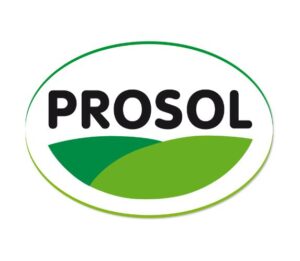 I-CARE: boosting immunity to maximize energy for growth and performance.
I-CARE: boosting immunity to maximize energy for growth and performance.
In poultry farming, illnesses such as Marek’s disease, Gumboro disease, and Newcastle disease are highly feared and are controlled with appropriate vaccination plans already implemented in hatcheries. Other diseases, such as coccidiosis, can be controlled with the use of vaccines or coccidiostatic substances, while necrotic enteritis is managed through sanitary measures.
The use of vaccines stimulates the production of antibodies to prevent the onset of the disease, provided that the immune system can respond to the vaccine stress. For example, Gumboro disease, described in 1962, has seen significant scientific progress and innovations in the poultry sector, with the genetic selection of fast-growing animals and laying hens that continue to produce eggs for over a hundred weeks without molting.
Neuroscience research has also made enormous progress: it has now been demonstrated that neuronal activity exists not only within the cranial cavity but also throughout the entire body. The typical molecules produced by neurons, neuropeptides, and their corresponding receptors have been found in organs beyond the brain.
Neuropeptides are tiny molecules produced by neurons that serve to communicate messages to other neurons and to other cells with corresponding receptors, operating through a lock-and-key mechanism. Ganglia, which are ovoid structures invisible to the naked eye, consist of clusters of neuron cell bodies (ganglion cells) surrounded by connective tissue. Axons and dendrites extend from these ganglia, forming both sensory and motor nerve fibers.
Ganglia are distributed throughout the body; they are found alongside the spinal column but also in large numbers in the wall of the intestine, both in the submucosa (Meissner’s plexus) and between the longitudinal and circular layers of the muscularis externa (Auerbach’s plexus), where they regulate various functions of the digestive system.
An intriguing aspect is that unlike other peripheral districts, the gastrointestinal tract continues to function even if its connections (nerve fibers) to the brain and spinal cord are severed; that is, if a segment of intestine is isolated from the central nervous system, it retains its functionality. In contrast, organs such as the bladder, respiratory system, and muscular systems require oversight from brain centers to function properly.
Moreover, other parts of the body exhibit specific neuronal capabilities. For example, neurotransmitters produced by neurons not only act on other neurons but also on various cells such as macrophages, which are part of the immune system and circulate throughout the body to defend against infections. Immune cells themselves produce certain neurotransmitters, highlighting a connection between the central nervous system and the immune system.
This connection is represented by Langerhans cells, a group of dendritic cells that recognize foreign agents (antigens) and present them to T lymphocytes, the primary effectors of the immune defense.
Neuroimmunology is the science dedicated to studying the interaction between the nervous and immune systems. This field of research helps us understand the complexity of the body’s immune organization and how any alteration in this organization can lead to an imbalance in the immune response.
Inflammation and immune response
Nonspecific or innate immunity is a type of defence mechanism that is present from birth. It predominates in individuals whose immune system is not yet fully developed and therefore cannot provide specific and targeted responses to pathogens. This immune system includes various types of cells such as lymphocytes, mast cells, eosinophils, basophils, macrophages, neutrophils, and dendritic cells, all capable of recognizing and destroying pathogens.
In infectious diseases, when a pathogen such as a virus, bacterium, or parasite attacks tissues, it triggers inflammation as a mechanism of nonspecific innate immune defense. This innate response protects the organism from the harmful action of pathogens. Characteristics of inflamed tissue include:
- redness due to increased blood flow (rubor),
- swelling due to edema (tumor),
- elevated temperature (calor),
- compromised function of the affected area due to structural imbalances induced by inflammation.
Inflammation aims to rid the body of the causal agent and is not confined to a local phenomenon. Various molecules synthesized and released by cells involved in inflammation enter the bloodstream and act on distant organs, primarily the liver, stimulating it to produce other molecules responsible for the inflammatory response. The course of inflammation can be acute or chronic, depending on the intensity and duration of the inflammatory stimulus, the site of inflammation, and the host’s response.
Acute inflammation can resolve completely with healing or scar formation, with replacement of the damaged tissue with fibrous tissue, or it can progress towards a chronic phlogosis with prolonged inflammation. In this case the process of chronicization and the replacement of the affected tissue with connective tissue will compromise the achievement of high production standards.
In the case of the broiler intestine, inflammation can impair nutrient absorption, decrease feed conversion, and consequently reduce weight gain. This type of inflammation is often triggered by TRL receptors on the intestinal epithelium, activated by the presence of bacterial compounds, leading to broiler dysbiosis. This condition is characterized by a high presence of inflammatory cells infiltrating the intestinal mucosa, causing deformation and shortening of intestinal villi. Dysbiosis can occur in broiler even in the absence of pathogens.
The intestinal immune system consists of enterocytes, which act as a physical barrier, and gut-associated lymphoid tissue (GALT), including various immune cells such as B lymphocytes, T lymphocytes, dendritic cells, and M cells organized in Peyer’s patches. These cells can recognize specific molecular structures associated with potentially harmful pathogens by binding through specific recognition receptors.
β-glucans are molecules recognized by the immune system as foreign, and their mechanism of action is based on binding to specific PRRs (pattern recognition receptors) present on the surface of innate immune system cells.
The β-glucans are linear glucose polysaccharides, linked by glycosidic bonds in the β-(1-3) position, with branches of glucose attached via β-(1-6) or β-(1-2) glycosidic bonds (Figure 1).
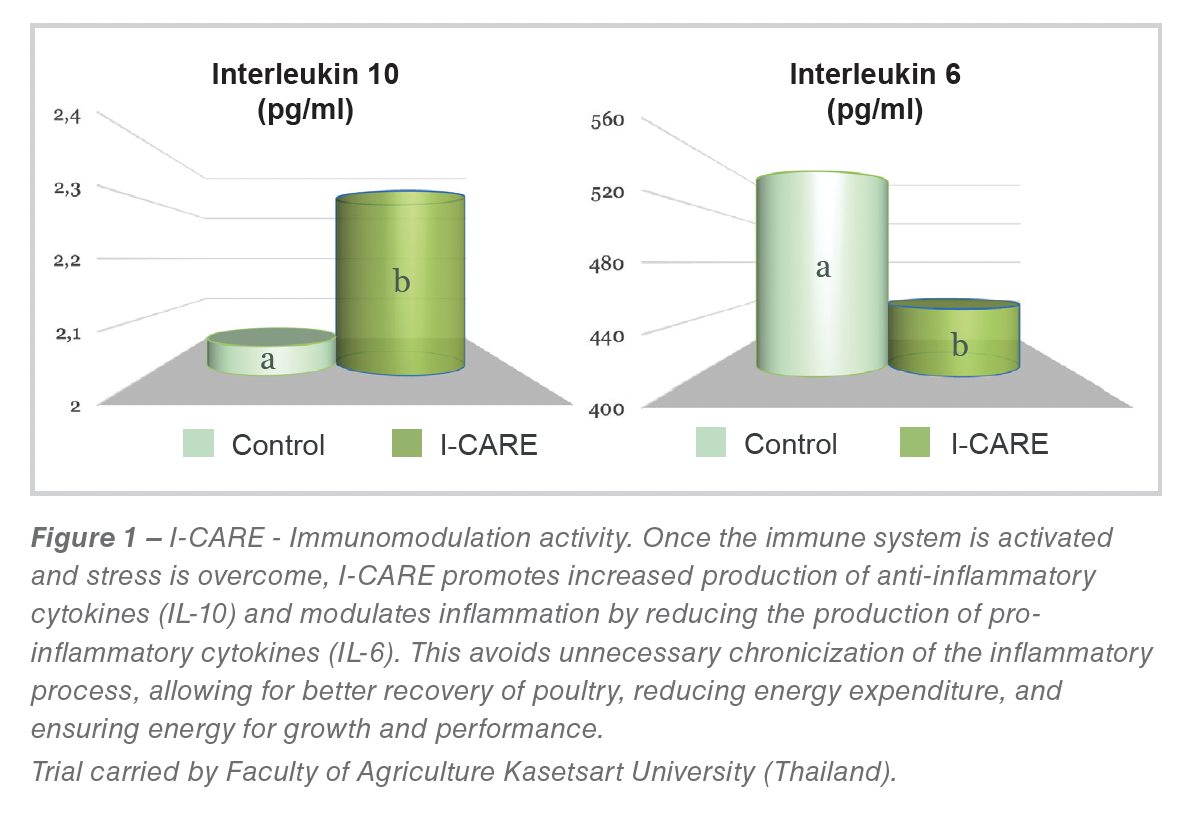 The macromolecular structure of these carbohydrates varies depending on the source:
The macromolecular structure of these carbohydrates varies depending on the source:
- The cell wall of yeasts and fungi is composed of linear chains with β-(1-3) linkages and glucose branches connected by β-(1-6) bonds.
- Cereal cell walls contain only linear chains of glucose linked by alternating β-(1-3) and β-(1-4) bonds.
- The cell walls of bacteria are composed of linear chains linked by β-(1-3) bonds.
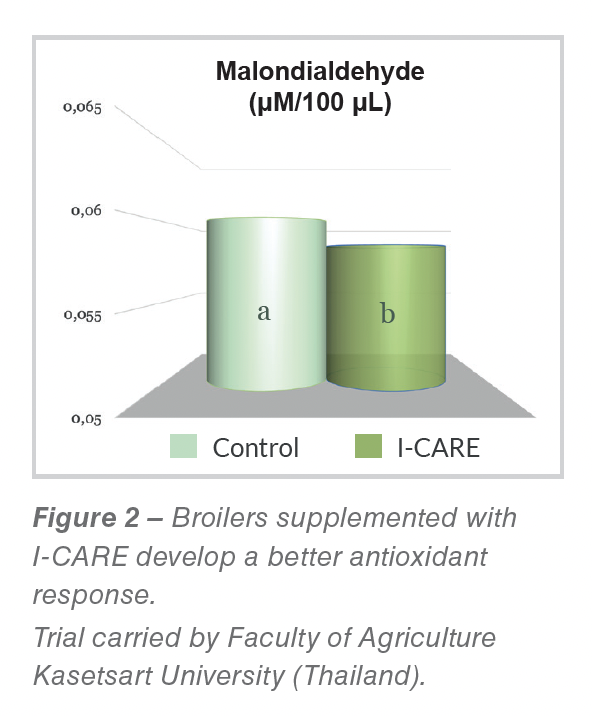 Depending on the source (yeasts, algae, bacteria, and cereals cell wall), β-glucans differ significantly in their solubility, structure, degree of branching, molecular weight, and all these characteristics greatly influence their ability to effectively perform this immunomodulatory activity.
Depending on the source (yeasts, algae, bacteria, and cereals cell wall), β-glucans differ significantly in their solubility, structure, degree of branching, molecular weight, and all these characteristics greatly influence their ability to effectively perform this immunomodulatory activity.
The ability to stimulate specific receptors necessary for activating the immune system is indeed ensured only in β-glucans containing β-(1-3)-(1-6) linkages and an appropriate degree of branching. For this reason, over the years Prosol SPA has selected a specific strain of yeast that, through a careful and gentle hydrolysis process, enhances the bioavailability of β-glucans with β-(1-3)-(1-6) linkages found in yeast cell walls, making them more bioactive in modulating the animal’s immune response
This leads to an enhanced phagocytic activity by immune cells specialized for this function: granulocytes, monocytes, macrophages, and dendritic cells. Among these, macrophages and dendritic cells play a crucial role due to their abundance of receptors (such as Dectin-1) that specifically recognize β-glucans. The binding of β-glucans to the receptor activates these specific immune system cells, enhancing their chemotaxis.
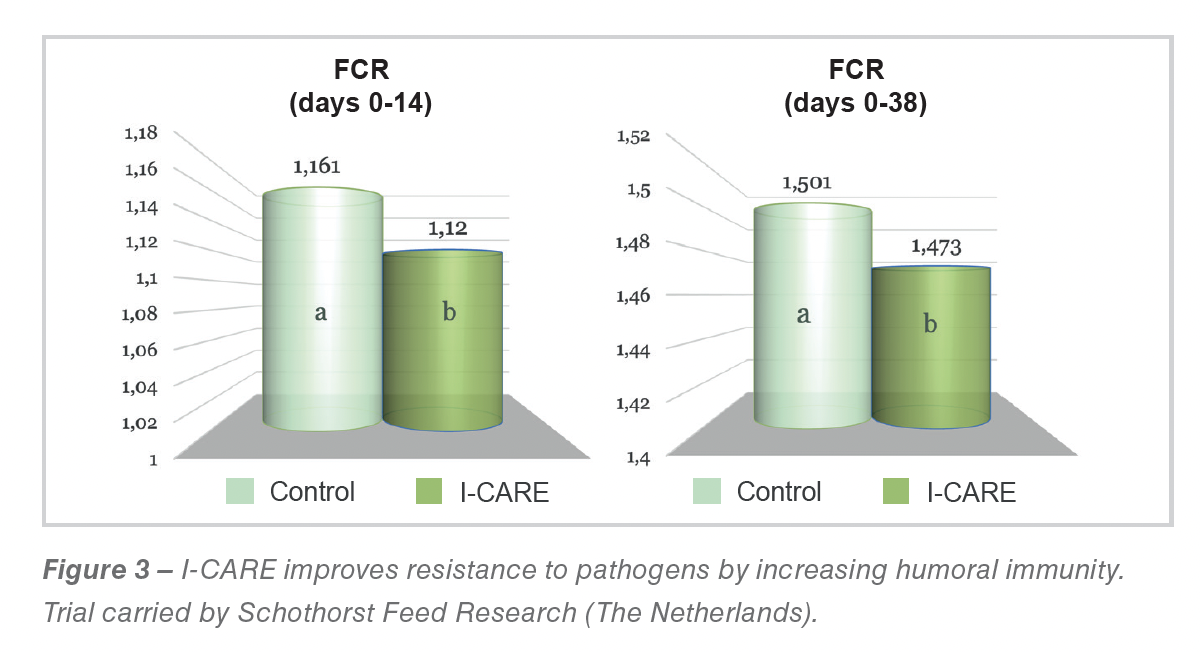 At the same time, thanks to its specific mode of action, I-CARE reduces serum levels of pro-inflammatory cytokines by limiting the inflammatory response, up to turn it off, preventing its chronicization, favouring the healing process: inflammation leads high energy expenditure which negatively impacts weight gain (Figure 2).
At the same time, thanks to its specific mode of action, I-CARE reduces serum levels of pro-inflammatory cytokines by limiting the inflammatory response, up to turn it off, preventing its chronicization, favouring the healing process: inflammation leads high energy expenditure which negatively impacts weight gain (Figure 2).
Finally, by limiting the depletion of glutathione, one of the largest cellular antioxidants, it maintains a good antioxidant action and guarantees a high protection against free radicals (Figure 3).
Another important element that distinguishes I-CARE is the presence of nucleic acids, macromolecules consisting of nucleotides. These molecules play a supporting function not only in the action of immunomodulation, but an important role is also related to the synthesis of proteins, a crucial process for growth and cellular function.
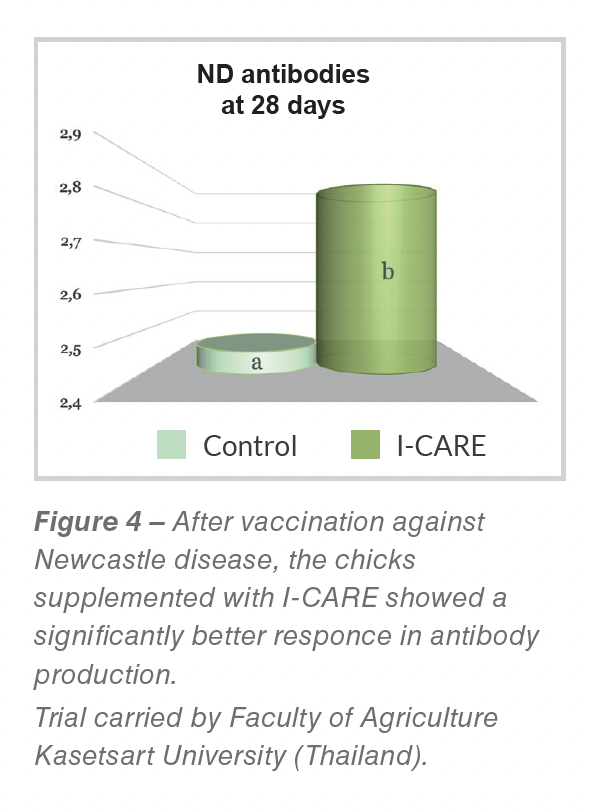 Moreover, the supplementation of nucleic acids in poultry diets has been widely demonstrated to enhance chickens’ ability to adapt and respond to environmental stress and nutritional stimuli. This improvement in adaptability and response leads to better overall health and productivity, ultimately enhancing the animal’s genetic performance.
Moreover, the supplementation of nucleic acids in poultry diets has been widely demonstrated to enhance chickens’ ability to adapt and respond to environmental stress and nutritional stimuli. This improvement in adaptability and response leads to better overall health and productivity, ultimately enhancing the animal’s genetic performance.
Let’s not forget how a healthy intestine with correct intestinal morphology is crucial not only for nutrient absorption, improving the conversion rate in the most significant stages of breeding (Figure 3), but also plays an important role as a barrier against pathogens. The nucleic acids, MOS, glutamic acid, precursor of glutamine, and β-glucans contained in I-CARE work precisely in this direction, supporting proper intestinal morphology and enabling the correct synthesis of vaccine-origin antibodies improving chicken’s immunity and ensuring broiler performance (Figure 4).


















